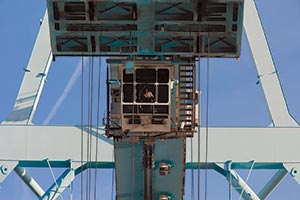Mediators Enter West Coast Talks;Port Terminals Remain Congested

This story appears in the Jan. 12 print edition of Transport Topics.
Federal mediators last week entered the slow-moving West Coast port labor talks in an effort to speed an agreement, as unseasonable delays continue to plague Southern California’s freight network.
The Federal Mediation and Conciliation Service joined the talks between the International Longshore & Warehouse Union and the Pacific Maritime Association on Jan. 6. Negotiations covering nearly 20,000 workers, who move more than half of the nation’s international container cargo, enter their ninth month today.
While negotiators met at the headquarters of PMA with management and union representatives, one Southern California trucking leader told Transport Topics last week that drivers’ trip times through container terminals “are the worst ever” for this time of year.
January cargo levels at Los Angeles and Long Beach, California, last year were about 15% lower than the peak August-October period.
“Every trucking company has had trouble getting loads out and also getting empties back into terminals,” said Fred Johring, president of Golden State Express and chairman of the Harbor Trucking Association trade group. “We are still tremendously congested.”
Johring said 37% of truckers spend two hours or more inside terminals, more than double the minimally acceptable time. As a result, he said, drivers are losing one or two trips daily, hurting their productivity and pay that is made by the trip.
Johring also said there have been times when “there is some moderate improvement in terminal operations.”
The Federal Mediation and Conciliation Service’s involvement has been sought by shippers for two months and by the PMA for at least a month, but mediation didn’t begin until ILWU also requested it.
Mediators’ contribution may not lead to an immediate agreement if the experience with East and Gulf Coast port contract talks is an indication.
In that case, it took six months from the time Federal Mediation and Conciliation Service entered the fray until an agreement was reached in early 2013.
Meanwhile, PMA-represented terminal operators this month cut back the number of crane operators. Typically, there are about 100 assigned to dock work daily. The number was dropped to 35 after the union wouldn’t allow lesser-trained workers at job sites, PMA said.
On the seas, the Marine Exchange of Southern California reported on Jan. 7 that seven containerships were waiting to unload.
Capt. Kit Louttit, executive director of the cargo-monitoring agency, told TT there were no congestion delays at this time last year. The peak containership delay count was 12 in late November.
Delays average three to seven days, Louttit said, though one vessel sat at anchor for 17 days, as of Jan. 7.Congestion also affects the intermodal rail network.
BNSF Railway, the largest intermodal rail operator, imposed a two-day embargo that ended Jan. 7 to unclog its network. The move affected westbound container freight received from other railroads that was bound for Southern California.
“Though unresolved labor issues continue to limit marine terminal productivity and impede normal supply chain flows, westbound pipelines have become manageable,” BNSF spokeswoman Amy Casas told TT. “BNSF Railway is encouraged that parties involved have agreed to mediation.”
Competitor Union Pacific Railroad continues to restrict Pacific Northwest traffic but is considering whether to lift the restrictions, spokeswoman Calli Hite told TT on Jan. 8.
She added that there are no significant intermodal backlogs in the Nebraska-based carrier’s system.
“As always, we are monitoring all port operations to evaluate traffic flows, minimize network interruptions and meet our customer commitments,” she added.
Johring said chassis continue to be an issue, too.
“The supply of chassis is still very tight,” Johring said. “That is still one of the major causes of the congestion.”
Port officials told TT they hope the emergence of a regional chassis pool in February that includes more than 85% of Southern California chassis will improve chassis flow.
The ports also have been exploring other traffic improvement steps, such as a temporary drop-off yard for empty containers at Long Beach.
In response to the delays, intermodal truckers are imposing congestion surcharges ranging up to $150 per load, Johring said, as well as raising detention pay and boosting rates for new customers.
With productivity cut, fleets are offering higher pay to drivers and turnover is increasing, Johring added.
“We’ve lost a number of drivers,” the Harbor Trucking Association official said. “There is a lot of cannibalism going on” as fleets raise pay.
“We’ve replaced the drivers we have lost,” Johring said. “The drivers are not leaving the industry. They are just looking for higher wages.”

